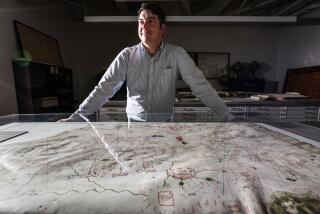Obsolete Nautical Charts Blamed for Accidents : Shipping: New technology that is expected to be in use in the next two or three years will make data more accurate and considerably easier to produce.
- Share via
How deep is the ocean? How wide is the sea?
Neither as deep nor wide as the world’s many outdated nautical charts show.
Vast stretches of coastlines around the globe have never been accurately surveyed. The locations of many small islands hundreds of miles distant from mainlands are known only approximately.
Parts of New York Harbor, where 24,000 ships arrive and depart every year, are still charted with data collected in the 1800s, using primitive lead-weighted lines to determine depths.
Results of relying on outdated charts can range from the merely embarrassing, as when the British luxury liner Queen Elizabeth II bumped into some unnoted rocks off the coast of Massachusetts in August, to the potential full-blown disaster.
In 1989, a Japanese ship approaching a harbor on the southeast coast of Alaska struck an uncharted underwater peak 10 feet beneath the surface. The last survey of those waters, taken by lead line in 1917, showed a depth of 66 feet. A resurvey after the accident revealed several other pinnacles the lead-line soundings had missed.
The second-largest oil spill in Alaskan history occurred in 1987, when the oil tanker Glacier Bay struck a rock in an area of Alaska’s Cook Inlet that was not precisely charted. The area’s $50-million salmon fishery had to shut down.
A $100-million lawsuit brought by the shipping company against the National Oceanographic and Atmospheric Administration (NOAA) is still pending. NOAA has legal responsibility for producing accurate charts in the United States.
New technology that is expected to be in use in the next two or three years will make nautical charts more accurate and considerably easier to produce.
But because updating charts will still be expensive and time-consuming, experts believe that maritime accidents caused by faulty chart information will continue for the foreseeable future.
“It’s very definitely a problem,” Christian Andreasen, head of the Monaco-based International Hydrographic Bureau, said. “And it’s not something you can do much about instantly.”
Although most people now travel by air, cruise ships are increasingly popular. The capacity of world cruise ships is growing at 11% annually and will increase 50% by 1994, based on ships now on order.
But a more immediate concern is shipping--including hazardous cargoes such as petroleum. In the United States, 99.8% of all foreign trade by weight is carried by marine transportation.
Because of high operating costs, captains of tankers and other freight vessels are under constant pressure to reduce the time they are underway. Some are tempted to stray out of well-charted shipping lanes into poorly charted areas in search of shortcuts.
“If you don’t give mariners good data, people are going to get into trouble and you’re going to have an oil spill to contend with that costs billions of dollars once it happens,” said Andreasen, who recently retired as deputy chief of operations for NOAA’s uniformed corps.
Erosion and storms change shorelines. Some coastal lands, as in southern Louisiana and southeastern Texas, are sinking. Water depths change over time because of such factors as silting and shifting currents.
NOAA officials have long complained that they lack the resources necessary to keep nautical charts reasonably up to date.
During an investigation of the Queen Elizabeth II grounding, Capt. Donald Suloff, deputy director of NOAA’s survey branch, testified that of the 90,000 miles of U.S. shoreline, at least half are charted on information that is at least 50 years old.
Other than its tanker routes, Prince William Sound, site of the largest oil spill in U.S. history when the Exxon Valdez hit a reef there in 1989, has not been resurveyed since a 1964 Alaska earthquake uplifted the bottom.
Many charts elsewhere around the globe are even further out of date.
“The world doesn’t have its shorelines very current,” said Andreasen, whose organization coordinates the charting efforts of its 58 member nations. “New surveys aren’t done on a cyclical basis, with enough accuracy.”
Ocean depths are determined by acoustic sounding devices. The devices send out a sound signal and measure the time it takes to receive an echo from the bottom.
More recent “multibeam” technology, involving multiple sound signals combined with computer analysis, soon will make it possible to chart larger areas.
Coastlines are charted from aerial photography. New Global Positioning System satellite technology will speed up that process by eliminating the need for survey parties on the ground to mark known positions.
Within a few years, Andreasen said, the newer technology will make a five-year cycle of updating feasible for most of the United States.
Meanwhile, let the mariner beware.
More to Read
Sign up for Essential California
The most important California stories and recommendations in your inbox every morning.
You may occasionally receive promotional content from the Los Angeles Times.










